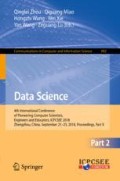Abstract
Text sentiment analysis is used to find out how much the public’s appreciation and preferences for specific events or objects. In order to effectively extract the deep emotional features of words, this paper proposes two sentiment analysis methods, which are emotion adjustment method based on semantic similarity and skip-gram model. In these two methods, word vectors containing semantic information obtained from Word2vec and emotional seeds are used to adjust the sentiment orientation of the words so that word vectors can trained both the semantic information and the sentiment contents. And the TF-IDF method is used to calculate the word’s weight in the text, the vector of the whole text is represented by adding the weighted word vectors. Experiments show that the emotion-adjusted word vector improves the accuracy of the text sentiment analysis more effectively than the traditional method, and proves the validity of these two methods in the sentiment analysis task. At the same time, the emotion adjustment method based on skip-gram model is more effective than the method based on semantic similarity.
Access this chapter
Tax calculation will be finalised at checkout
Purchases are for personal use only
References
CNNIC. http://www.cnnic.net.cn/hlwfzyj. Accessed 31 Jan 2018
Kwak, H., Lee, C., Park, H., et al.: What is Twitter, a social network or news media? In: International Conference on World Wide Web, pp. 591–600 (2010)
Paccanaro, A., Hinton, G.E.: Learning distributed representations of concepts using linear relational embedding. IEEE Trans. Knowl. Data Eng. 13(2), 232–244 (2002)
Pennington, J., Socher, R., Manning, C.: Glove.: global vectors for word representation. In: Conference on Empirical Methods in Natural Language Processing, pp. 1532–1543 (2014)
Mikolov, T., Corrado, G., Chen, K., et al.: Efficient estimation of word representations in vector space. In: International Conference on Learning Representations, pp. 1–12 (2013)
Hatzivassiloglou, V., Mckeown, K.R.: Predicting the semantic orientation of adjectives. In: Eighth Conference on European Chapter of the Association for Computational Linguistics, pp. 174–181. Association for Computational Linguistics (1997)
Turney, P.D.: Thumbs up or thumbs down?: Semantic orientation applied to unsupervised classification of reviews. In: Meeting on Association for Computational Linguistics, pp. 417–424 (2002)
Niu, Y., Pan, M., et al.: Emotion analysis of Chinese microblogs using lexicon-based approach. Comput. Sci. 41(9), 253–258, 289 (2014)
Pang, B., Lee, L., Vaithyanathan, S.: Thumbs up? Sentiment classification using machine learning techniques. In: ACL-02 Conference on Empirical Methods in Natural Language Processing, pp. 79–86. Association for Computational Linguistics (2002)
Mullen, T., Collier, N.: Sentiment analysis using support vector machines with diverse information sources. In: Conference on Empirical Methods in Natural Language Processing, EMNLP 2004, A Meeting of Sigdat, A Special Interest Group of the ACL, Held in Conjunction with ACL 2004, 25–26 July 2004, Barcelona, Spain, pp. 412–418. DBLP (2004)
Wang, S., Manning, C.D.: Baselines and bigrams: simple, good sentiment and topic classification. In: Meeting of the Association for Computational Linguistics: Short Papers, pp. 90–94. Association for Computational Linguistics (2012)
Li, S., Huang, L., Wang, J., et al.: Semi-stacking for semi-supervised sentiment classification. In: Meeting of the Association for Computational Linguistics and the, International Joint Conference on Natural Language Processing, pp. 27–31(2015)
Sun, J., Xueqiang, L., Zhang, L.: On sentiment analysis of Chinese microblogging based on lexicon and machine learning. Comput. Appl. Softw. 31(7), 177–181 (2014)
Jiang, J., Xia, R.: Microblog sentiment classification via combining rule-based and machine learning methods. In: NLPCC (2016)
Morin, F., Bengio, Y.: Hierarchical probabilistic neural network language model. In: AISTATS (2005)
Mikolov, T., Sutskever, I., Chen, K., et al.: Distributed representations of words and phrases and their compositionality, vol. 26, pp. 3111–3119 (2013)
HowNet. http://www.kenage.com
tsinghua.:http://nlp.csai.tsinghua.edu.cn/site2/index.php/zh/resources/13-v10
Author information
Authors and Affiliations
Corresponding author
Editor information
Editors and Affiliations
Rights and permissions
Copyright information
© 2018 Springer Nature Singapore Pte Ltd.
About this paper
Cite this paper
Song, M., Wang, Y., Liu, Y., Zhao, Z. (2018). Text Sentiment Analysis Based on Emotion Adjustment. In: Zhou, Q., Miao, Q., Wang, H., Xie, W., Wang, Y., Lu, Z. (eds) Data Science. ICPCSEE 2018. Communications in Computer and Information Science, vol 902. Springer, Singapore. https://doi.org/10.1007/978-981-13-2206-8_5
Download citation
DOI: https://doi.org/10.1007/978-981-13-2206-8_5
Published:
Publisher Name: Springer, Singapore
Print ISBN: 978-981-13-2205-1
Online ISBN: 978-981-13-2206-8
eBook Packages: Computer ScienceComputer Science (R0)

